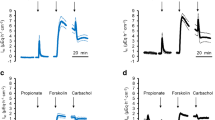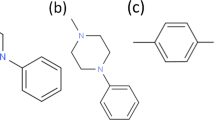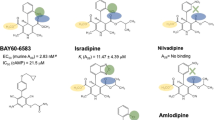Abstract
Previously we have shown that arylamino-benzoates like 5-nitro-2-(3-phenylpropylamino)-benzoate (NPPB), which are very potent inhibitors of NaCl absorption in the thick ascending limb of the loop of Henle, are only poor inhibitors of the cAMP-mediated secretion of NaCl in rat colon. This has prompted our search for more potent inhibitors of NaCl secretion in the latter system. The chromanole compound 293 B inhibited the equivalent short-circuit current (I sc) induced by prostaglandin E2 (n=7), vasoactive intestinal polypeptide (VIP,n=5), adenosine (n=3), cholera toxin (n=4) and cAMP (n=6), but not by ionomycin (n=5) in distal rabbit colon half maximally (IC50) at 2 μmol/l from the mucosal and at 0.7 μmol/l from the serosal side. The inhibition was reversible and paralleled by a significant increase in transepithelial membrane resistance [e.g. in the VIP series from 116±16 Ω·cm2 to 136±21 Ω·cm2 (n=5)]. A total of 25 derivatives of 293 B were examined and structure activity relations were obtained. It was shown that the racemate 293 B was the most potent compound with-in this group and that its effect was due to the enantiomer 434 B which acted half maximally at 0.25 μmol/l. Further studies in isolated in vitro perfused colonic crypts revealed that 10 μmol/l 293 B had no effect on the membrane voltage across the basolateral membrane (V bl) in non-stimulated crypt cells: −69±3 mV versus −67±3 mV (n=10), whilst in the same cells 1 mmol/l Ba2+ depolarised (V bl) significantly. However, 293 B depolarised (V bl) significantly in the presence of 1 μmol/l forskolin: −45±4mV versus −39±5 mV (n=7). Similar results were obtained with 0.1 mmol/l adenosine. 293 B depolarised (V bl) from −40±5 mV to −30±4 mV (n=19). This was paralleled by an increase in the fractional resistance of the basolateral membrane. VIP had a comparable effect. The hyperpolarisation induced by 0.1 mmol ATP was not influenced by 10 μmol/l 293 B: −75±6 mV versus −75±6 mV (n=6). Also 293 B had no effect on basal K+ conductance (n=4). Hence, we conclude that 293 B inhibits the K+ conductance induced by cAMP. This conductance is apparently relevant for Cl− secretion and the basal K+ conductance is insufficient to support secretion.
Similar content being viewed by others
References
Böhme M, Diener M, Rummel W (1991) Calcium- and cyclic AMP-mediated secretory responses in isolated colonic crypts. Pflügers Arch 419:144–151
Burckhardt BC, Gögelein H (1992) Small and maxi K+ channels in the basolateral membrane of isolated crypts from rat distal colon. Pflügers Arch 420:54–60
Cabantchik ZI, Greger R (1992) Chemical probes for anion transporters of mammalian cell membranes. Am J Physiol 262:C803-C827
Cliff WH, Worrell RT, Frizzell RA (1990) Conductance path-ways involved in chloride secretion and their regulation. In: Tsui LC, Greger R, Romeo G. (eds) The identification of the cf gene: recent progress and new research strategies. Plenum, New York, p 197–208
Diener M (1994) Segmental differences along the crypt axis in the response of cell volume to secretagogues or hypotonic medium in the rat colon. Pflügers Arch 426:462–464
Diener M, Rummel W (1989) Actions of the Cl− channel blocker NPPB on absorptive and secretory transport processes of Na+ and Cl−in rat descending colon. Acta Physiol Scand 137:215–222
Edwards G, Weston AH (1990) Structure-activity relationships of K-openers. Trends Pharmacol Sci 11:417–422
Greger R (1981) Cation selectivity of the isolated perfused cortical thick ascending limb of Henle's loop of rabbit kidney. Pflügers Arch 390:30–37
Greger R, Schlatter E, Wang F, Forrest JNJ (1984) Mechanism of NaCl secretion in rectal gland tubules of spiny dogfish (Squalus acanthias). III. Effects of stimulation of secretion by cyclic AMP. Pflügers Arch 402:376–384
Greger R, Bleich M, Schlatter E (1991) Ion channel regulation in the thick ascending limb of the loop of Henle. Kidney Int 404 [Suppl 33]:S119-S124
Greger R, Nitschke RB, Lohrmann E, Burhoff I, Hropot M, Englert HC, Lang HJ (1991) Effects of chloride channel blockers on equivalent short circuit current in rabbit colon. Pflügers Arch 419:190–196
Hamill OP, Marty A, Neher E, Sakmann B, Sigworth FJ (1981) Improved patch-clamp techniques for high-resolution current recording from cells and cell-free membrane patches. Pflügers Arch 391:85–100
Kubitz R, Warth R, Allert N, Kunzelmann K, Greger R (1992) Small conductance chloride channels induced by cAMP, Ca2+, and hypotonicity in HT29 cells: ion selectivity, additivity, and stilbene sensitivity. Pflügers Arch 421:447–454
Kunzelmann K, Grolik M, Kubitz R, Greger R (1992) cAMP-dependent activation of small-conductance Cl− channels in HT29 colon carcinoma cells. Pflügers Arch 421:230–237
Kunzelmann K, Kubitz R, Grolik M, Warth R, Greger R (1992) Small conductance Cl− channels in HT29 cells: activation by Ca2+, hypotonic cell swelling and 9-Br-cGMP. Pflügers Arch 421:238–246
Lee NH, Muci AR, Jacobsen EN (1994) Entantiomerically pure epoxychromanes via asymetric catalysis. Tetrahedron Lett 32:5055–5058
Lewis SA, Hanrahan JW (1985) Apical and basolateral membrane ionic channels in rabbit urinary bladder epithelium. Pflügers Arch 405:S83-S88
Lohrmann E, Greger R (1993) Isolated perfused rabbit colon crypts: stimulation of Cl− secretion by forskolin. Pflügers Arch 425:373–380
Lohrmann E, Greger R (1994) Effect of secretagogues on ion conductances of in vitro perfused isolated rabbit colon crypts. Pflügers Arch: ⊠-⊠ MS-567
Lohrmann E, Cabantchik ZI, Greger R (1992) Transmitter induced changes of the membrane potential of HT29 cells. Pflügers Arch 421:224–229
Longman SD, Hamilton TC (1992) Potassium channel activator drugs: mechanism of action, pharmacological properties, and therapeutical potential. Med Res Rev 12:73–148
Loo DDF, Kaunitz JD (1989) Ca2+ and cAMP activated K+ channels in the basolateral membrane of crypt cells isolated from distal colon. J Membr Biol 110:19–28
Pavenstädt H, Lindeman S, Greger R (1990) Effect of cromakalim (BRL 34915) and glibenclamide on the membrane voltage and K+ channels of primary cultures of rabbit aorta vascular smooth muscle cells. Clin Pharmacol 7:19–23
Schulzke JD, Fromm M, Hegel U (1986) Epithelial and subepithelial resistance of rat large intestine: segmental differences, effect of stripping, time course, and action of aldosterone. Pflügers Arch 407:632–637
Siemer C, Gögelein H (1992) Activation of non-selective cation channels in the basolateral membrane of rat distal colon crypt cells by prostaglandin E2. Pflügers Arch 420:319–328
Siemer CG, Gögelein H (1993) Effects of forskolin on crypt cells of rat distal colon. Activation of nonselective cation channels in the crypt base and of chloride conductance in other parts of the crypt. Pflügers Arch 424:321–328
Tabcharani JA, Low W, Elie D, Hanrahan JW (1990) Low-conductance chloride channel activated by cAMP in the epithelial cell line T84. FEBS Lett 270:157–164
Tilmann M, Kunzelmann K, Fröbe U, Cabantchik ZI, Lang HJ, Englert HC, Greger R (1991) Different types of blockers of the intermediate conductance outwardly rectifying chloride channel (ICOR) of epithelia. Pflügers Arch 418:556–563
Wangemann P, Wittner M, Di Stefano A, Englert HC, Lang HJ, Schlatter E, Greger R (1986) Cl−-channel blockers in the thick ascending limb of the loop of Henle. Structure activity relationship. Pflügers Arch 407 [Supp 2]:S128-S141
Warth R, Greger R (1993) The ion conductances of CFPAC-1 cells. Cell Physiol Biochem 3:2–16
Welsh MJ, Smith PL, Frizzell RA (1983) Chloride secretion by canine tracheal epithelium. III. Membrane and electromotive forces. J Membr Biol 71:209–218
Author information
Authors and Affiliations
Rights and permissions
About this article
Cite this article
Lohrmann, E., Burhoff, I., Nitschke, R.B. et al. A new class of inhibitors of cAMP-mediated Cl− secretion in rabbit colon, acting by the reduction of cAMP-activated K+ conductance. Pflügers Arch. 429, 517–530 (1995). https://doi.org/10.1007/BF00704157
Received:
Revised:
Accepted:
Issue Date:
DOI: https://doi.org/10.1007/BF00704157




